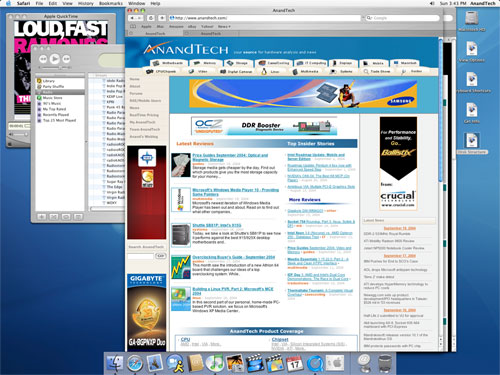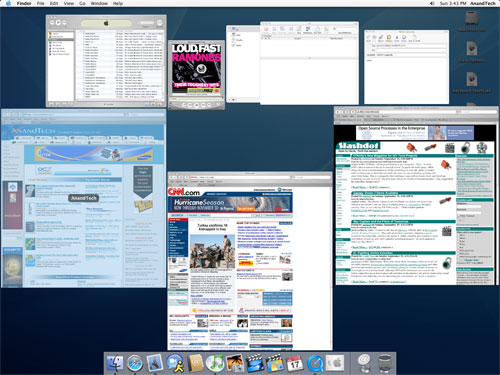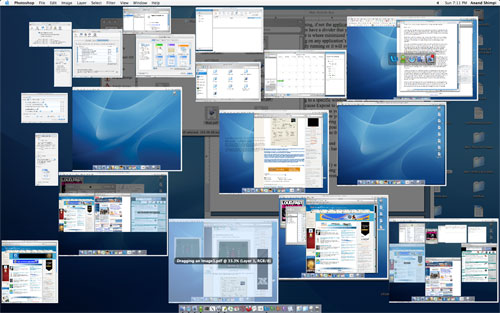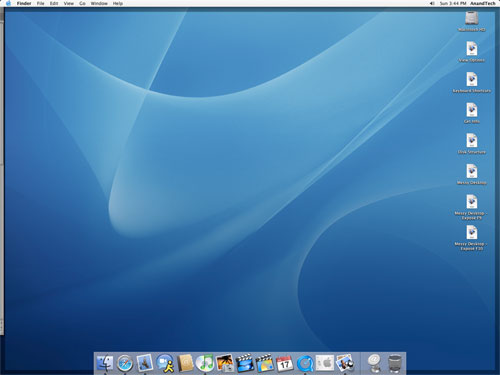A Month with a Mac: A Die-Hard PC User's Perspective
by Anand Lal Shimpi on October 8, 2004 12:05 AM EST- Posted in
- Mac
Perfect Multi-tasking
So far, I've described OS X's multi-tasking as very similar to what is currently available under Windows, but where OS X sets itself apart is in a little feature called Exposé (note that typing an accented "e" is extremely easy under OS X - ALT-e followed by the "e" key or any vowel will do just that).By default, Exposé is activated by one of three function keys - F9, F10 or F11. Each function key serves a different purpose, each of which is a feature of Exposé. The theory behind Exposé is simple: it is a way of getting to a specific window on your desktop as fast as possible.

We start with our cluttered desktop...
Click to enlarge.
Hitting F9, for example, will cause Exposé to zoom out all of your active visible (unhidden) windows and essentially, tile them across your desktop. Then, using either the keyboard or the mouse, you can select the window that you want and everything goes back to normal, with the window that you have selected appearing in the foreground. The rest of the windows are untouched and are all in their original positions. The window that you selected is also in its original position; it is simply moved to the front so that you can see it.

Hitting F9 activates Exposé across all applications.
Click to enlarge.
If you don't want to Exposé all windows, you can just Exposé the windows within a particular application (F10 by default), which is extremely handy for dealing with tons of images in Photoshop for example.

Hitting F10 activates Exposé across only a single application's windows.
Click to enlarge.

Another example of Exposé's usefulness in editing all of the images for this article in Photoshop.
Click to enlarge.
The final Exposé function lets you view your desktop (F11), which, to me, was like a more polished version of Windows-D, since after I was done doing whatever it is I needed to do on the desktop, Exposé deactivated and my screen was restored to its original state.

Hitting F11 reveals the desktop.
Click to enlarge.
The beauty of Exposé is difficult to convey in text alone. Honestly, the best way to evaluate it and understand its potential is to use it - luckily, there are Apple stores for this very purpose. Keep in mind that Exposé is very customizable as well and the three function keys that I mentioned above, although the defaults, are not the only ways that you can configure OS X to activate Exposé.
The benefits of Exposé are numerous. If you ever feel overwhelmed by having too many windows open, Exposé definitely alleviates that feeling as you don't have to tab through multiple applications to finally get to the window that you want. While Exposé does make having only a single display better, heavy multi-taskers will still enjoy the benefits of a dual display setup.
Since the OS X desktop environment is completely OpenGL accelerated, the performance of features like Exposé are not CPU limited - instead, they are GPU limited. Luckily, using Exposé with many windows open is not very stressful on even a Radeon 9600, but you do run out of video memory very quickly - in which case, your system ends up swapping to main memory over the AGP bus, making the Exposé animation considerably choppy. It seems that the sweet spot for more than a handful of windows open is around 128MB of video memory, with 256MB being perfect - needless to say, I found the mere 64MB that came on the Radeon 9600 which shipped with the system to be too little. There is no detriment to functionality if you don't have enough video memory; the Exposé animation simply becomes more choppy (which can be annoying on a $3000 system).










215 Comments
View All Comments
addragyn - Friday, October 8, 2004 - link
RE: Safari's SpeedThere is a delay built into the browser.
You can reduce it - http://www.oreillynet.com/pub/wlg/4924
David Hyatt is a Safari developer @ Apple, he covered this on his blog - http://weblogs.mozillazine.org/hyatt/archives/2004...
Zak - Friday, October 8, 2004 - link
The biggest problem with the article I sa so far is overlooking the iApps. Also, the apps equivalents are not correct. Entourage is Outlook counterpart and there is Acrobat Reader for OSX as well. Other than that it's a good article, but it's clear that Anand missed some things and got some others wrong, like the mentioned mouse cable, etc.Zak
azkman - Friday, October 8, 2004 - link
This was a very good editorial/experience piece. Compared to other articles by Windows-users trying Macs, it was very open-minded. However, I have to agree with some of the earlier posters. The hardware used was dated, and the reviewer did not mention some of the key strengths of the Mac platform.It seems to me that Windows-users are fixated on certain characteristics and define a computer by MHz, framerate, etc, and this came out to a certain degree in the review. The author readily admits that he is used to writing hardware pieces for this type of audience, and again, I applaud him for his open-mindedness.
Here is some information for posters and readers who want to learn more about Apple's computers and understand the overall value equation:
price - http://www.linuxinsider.com/story/36120.html
performance - http://www.linuxinsider.com/story/36964.html
proof - http://www.tcf.vt.edu/systemX.html
http://www.colsa.com/cover_page/news_front/news_de...
http://www.top500.org/list/2003/11/
http://www.roanoke.com/news/roanoke%5C6133.html
http://www.pcmag.com/review/0%2C2491%2Cs%3D1564&am...
http://www.pcmag.com/article2/0,1759,1369037,00.as...
Applications & tools included in the price (beyond normal MS Windows offerings):
video conferencing (high quality, easy to set-up, easy to use)
music creation
jukebox / music management / cd burning
photo management
movie editing
dvd authoring & burning
all-purpose search tool
PDF export from any printable page
font management
full development environment (c, c++, objective c, java, scripting...)
full unix shell, w/ x11
Yes, I know a few of these applications are included with Windows, but I work in a tech-savvy Windows-dominant company and none of my co-workers use the bundled programs. In fact, most of them don't video conference or edit videos.
Anyway, the Mac is really an "experience" in that the traditional concept of a computer disappears and the Mac becomes an extension of what the user wants to do. That is of course unless the user wants to work specifically with Windows issues. The value of a Mac comes from its ability to empower the user to do terrific things straight out of the box without thinking about things like viruses and security while also being a supercomputer-class piece of equipment.
rxmz - Friday, October 8, 2004 - link
Thanks, very good article.I agree with some earlier posts that the Unix aspect of Mac OS X is a big advantage over Windows. I have a company web server and mail server (with IMAP and web mail access) running on the same G4 tower that is used as a desktop (not an ideal setup, I know, but it has to suffice for now ;-). I have PostgreSQL, cvs, and Subversion installed on my PowerBook. I can ssh to the office to administer the mail or web server. The Unix foundation is a terrific aspect of the OS.
Anand, you might want to take a look at Camino for web browsing. And if you have a chance, check out the capabilities of AppleScript; it's cool now and only going to get more accessible to non-power users when Tiger comes out.
mjtomlin - Friday, October 8, 2004 - link
oops one other point to make on the GUI responsiveness ...OS X GUI is timed. Things happen at a constant rate based on time not on CPU speed ... a lot of bench-markers like to use the scrolling test ... to see which system is faster. This is not a vaild test, because Mac OS X times the speed. This is actually a feature of the system. The whole point of scrolling was to quickly skim through a document. If the system scrolls through the document too fast, how do you know what you're missing?
A lot of the GUI is designed like this ... that is, someone actually thought about the purpose of the feature and made sure it remained useful.
To get to the end of a document, just drag the scroll bar down to the bottom or press the "end" key on the keyboard ... you'll be there in less than a second, that was those were designed for.
mjtomlin - Friday, October 8, 2004 - link
A couple of points...#1 - i thought it was a fairly good article. You have to remember he was not writing a definitive guide to OS X/PowerMac. This was his take on the system from a Windows user perspective. There is obviously going to be a lot of details left out and many misunderstood "features"
#2 - poster #60 regarding patching security issues... Apple has been releasing security fixes for OS X ever since it was released. I believe we're up to a couple a month in fact. Most OS X users update their systems without incident and continue on... The biggest difference between OS X security patches and those for Windows is that all the security fixes for OS X are for issues that have NOT been exploited yet.
THERE WILL ALWAYS BE SECURITY ISSUES IN ANY OPERATING SYSTEM.
But because of OS X's open source base (Darwin/BSD) most security issues are discovered before they're ever exploited. The opposite of this is true under Windows.
#3 Dual CP's are not necessarily faster than a single CPU ... You have to remember, this is only true if the application that you're running is multi-threaded. And the OS itself is highly tuned for multi-tasking.
The GPU in the PowerMac does the screen drawing, so it doesn't make a difference how many CPU's are in the system.
#4 GUI responsiveness ... OS X using buffering to draw the GUI, Windows does not. This is obvious as seen under slower systems when trying to move windows around... XP will leave screen "artifacts" (garbage) ... OS X windows appear to "jerk" and "jump"
the end.
shuste73 - Friday, October 8, 2004 - link
I'm a Linux user (Slackware), and one of the biggest challenges to Linux continues to be the very people that are trying to promote it - poor, misguided zealots that reflect poorly on the entire community.Judging from the feedback to this article, I see that the Mac users are generally no different. It's a shame.
I thought the article was very good, personally, from the perspective of a long-time Microsoft user-turned-Slacker.
indd - Friday, October 8, 2004 - link
Although this is experiential writing I'm really surprised at the understatement of the difference between the OS's. The effort Apple has put into usability results in a very solid feel for the OS. Windows really feels very unsophisticated in comparison, especially in error handling.Which brings me to the fact that I'm disappointed to see the page on crashing so glossed over. Need examples of the Mac crashing to back it up! It really appeared like something was omitted here.
Reading the article leaves me with the feeling he really loves Windows, and still brought a lot of old anti-mac feelings into the experience. I don't want to sound harsh here, just relating my reactions to the article.
At least he tried :)
asimuth - Friday, October 8, 2004 - link
One of the hardest things I have ever tried to do was explain to someone why I use a Mac and why it is a different experience. In the end the explanation always comes down to "it is the little things". Your article was the best review I have read. You had a clearly stated experiential bias and you refused to let past predjudices get in the way of a thgoughful review.As a softcore geek I am disappointed that my platform of choice did not knock it out of the ballpark for you. Having said that, I think your criticisms are very valid. I will certainly want to refer people to this article to give them some idea of why I'm a Mac user.
In my working life I am the development manager for a small software company - windows only. You cannot imagine how frustrating it is to be without the small thoughtful additions that make my OSX experience.
: )
BopTop - Friday, October 8, 2004 - link
Great article, I haven't touched an apple computer since the powerpc days.An article like this will always have detractors, that apple hardware and pc hardware weren't comparable, dual cpu or single, etc. All I can say is re-read the first page - this wasn't to compare hardware, or really software. It was to compare the "experience" of using a system that has a different work method.
That's exactly what the article did, and did it excellently.